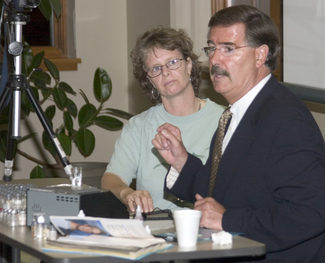Visiting scholar at CSC gives community medical lesson

Chadron State College alumnus Dr. Ken Emonds was on a mission last week. He used his time as a visiting scholar at his alma mater to educate people about the field of orthomolecular medicine, which has become his career and passion during the past 30 years.
During Emonds’ visit, he spoke to more than half a dozen classes and made two public presentations.
Emonds, who graduated from Chadron State in 1968, is the founder and clinical director of the New England Center for Orthomolecular Medicine at North Hampton, N.H.
Orthomolecular medicine, as Emonds describes it, is a complementary form of treatment which strives to rebuild the immune system and brain chemistry. He says it’s the future of medicine.
Emonds said most of today’s orthodox medicines, while useful, are xenobiotic, meaning that they are comprised of ingredients foreign to a person’s physical make-up. He promotes the complementary use of orthomolecular medicines, which, he said, “belong in the body.” Emonds combines the use of each to best serve the patient.
Emonds said his visit to Chadron State gave him a welcome opportunity to promote his form of treatment, which he said faces an uphill battle from pharmaceutical companies and the lawmakers – on both sides of the aisle -- they influence. He gave examples of several successful orthomolecular medicines that have been banned because of competition with more lucrative drugs.
He also said a few disreputable members of the field have given it bad publicity through the years.
During his final session with the public Friday night, Emonds responded to questions from inquisitive members of the audience – many of them senior citizens -- for more than four hours. “What about Alzheimer’s? What about Crohn’s, lupus? macular degeneration? fibromyalgia? …”
The doctor also demonstrated the process of electrodermal titration on two volunteer members of Friday’s audience, which consisted of about 100 people. Electrodermal titration is the method used to measure the exact molecular tissue needs of a patient.
He provided the “patients” an exact dosage after calculating their readings.
“There is no such thing as one size fits all,” he said. “Everybody is a unique person. I wouldn’t even give the same formula to identical twins.”
Volunteer Sherrie Emerson, a CSC employee who lives in Crawford, said the dose that Emonds gave her seemed to relieve neck pain before she left the presentation.
The doctor said students seeking a career in medicine will probably make more money following the traditional route, but encouraged them to become aware of orthomolecular methods and do what’s best for the patients.
“It’s humbling, hard work,” he said of his field. “A person could make a lot more money being a brain surgeon.”
Emonds said one of the weaknesses of the modern medical system is that the “family doctor’s” time restraints encourage referrals to specialists who don’t look at the body as a whole.
He said almost everyone can benefit from his type of treatment, but most don’t come to him until they are facing severe symptoms of autoimmunity or cancer.
The only person who Emonds says he hasn’t been able to “help,” was a child molester, who the doctor said didn’t want to change. “I told him the door was always open if he truly wanted help.”
He said orthomolecular medicine hasn’t been able to make people immortal or save every person from illness, but has made many dying patients much more comfortable during the process.
Emonds took an indirect route to his career in medicine.
After discontinuing studies for the Catholic priesthood, Emonds graduated from Chadron State College with an English degree and taught that subject at a Plymouth, Conn., high school for 12 years. He served as a Chadron policeman from 1966 through 1968.
While teaching, he earned a master’s degree in psychology from Connecticut’s Trinity College.
It was a personal bout with malaria in 1974 that initiated Emonds’ career in environmental medicine. He contracted the worst form of the disease while serving as a physician assistant on a Baptist mission in Kenya.
His doctor wouldn’t grant his patient’s request for experimental therapy for fear of reprisal from his supervisors and the Food and Drug Administration. The doctor did, however, give him some ideas about things he might try, and Emonds did the therapy on his own with ascorbic acid and baking soda. Obviously, it was a success.
After hearing of Emonds’ recovery, Dr. Linus Pauling, who earned Nobel Prizes in both chemistry and peace, invited him to study in California. Emonds spent the next four years at the Pauling Institute of Science and Medicine at Menlo Park, Calif., where he earned a “consortium” doctorate.
Emonds was invited to Chadron State as a visiting scholar after he received the college’s Distinguished Alumni Award and was its commencement speaker in May.
Category: Campus News
